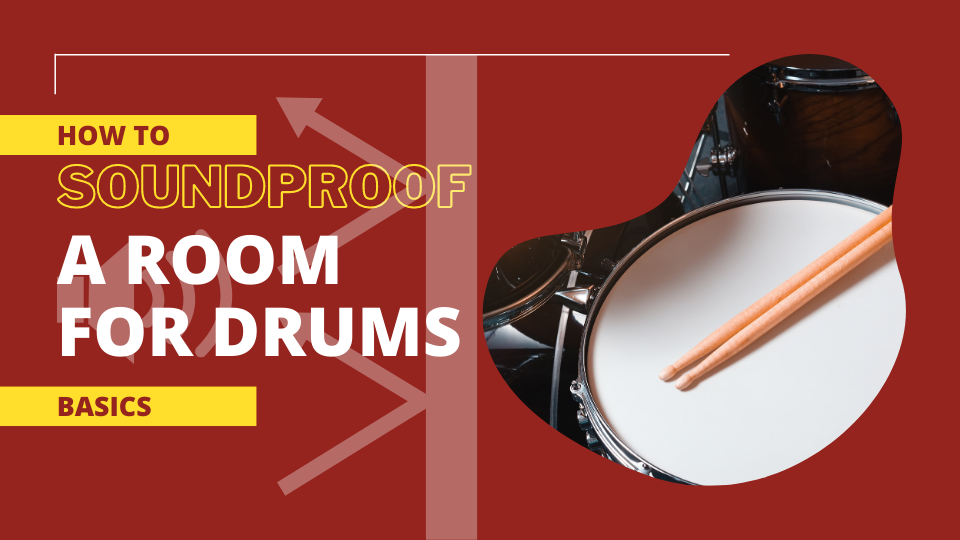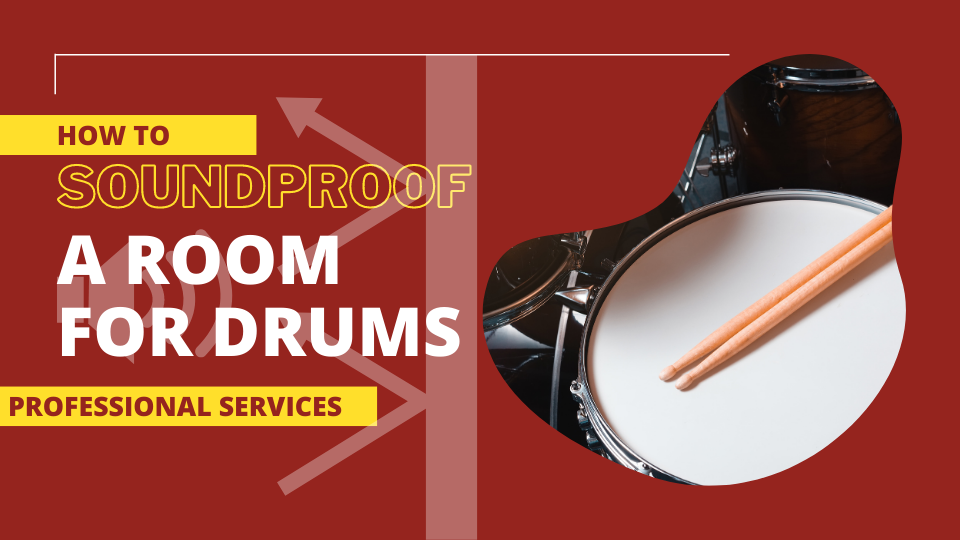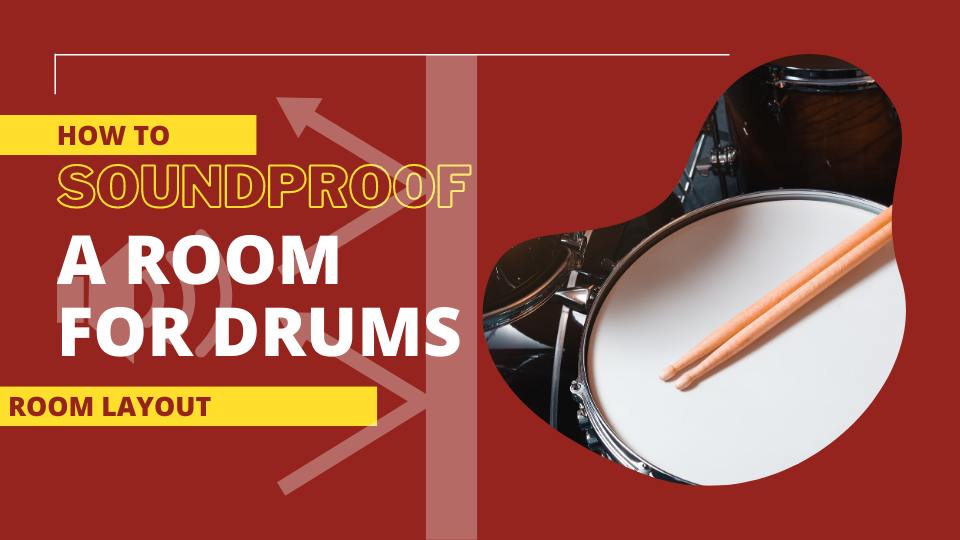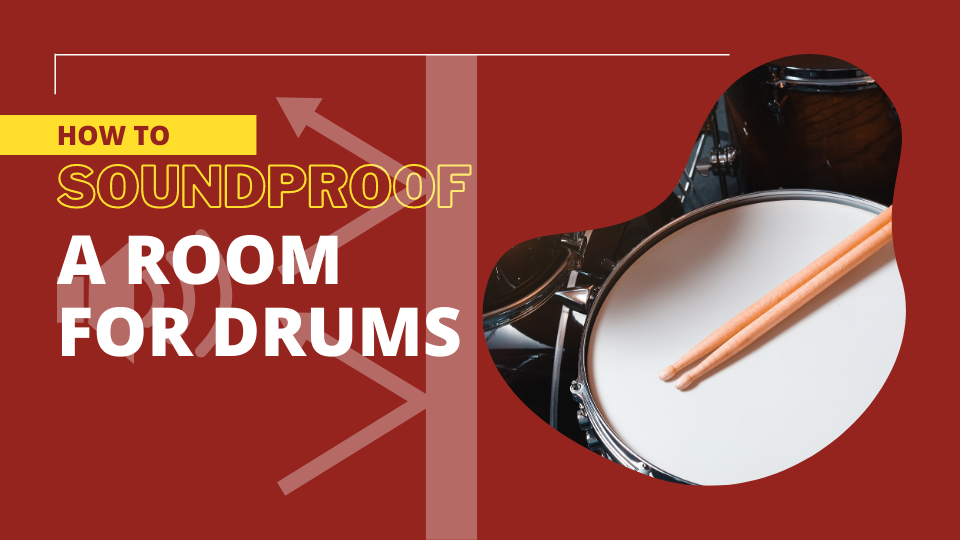This product list contains affiliate links. This means that at no extra cost to you, I may earn a commission if you use one of these links to make a purchase.
As someone who’s spent countless hours behind a drum kit, I understand the exhilarating rush that comes from drumming. The pure joy of creating rhythmic patterns, the satisfaction of nailing a complex drum fill, the thrill of being in sync with other musicians – it’s an experience like no other. But, like many of my fellow drummers, I’ve often been faced with the challenge of keeping the peace in shared spaces.
Yes, I’m talking about the ‘noise’. Drums, by their nature, are loud. Very loud. And while we drummers may relish the thunderous beats we produce, our neighbors, housemates, or family members may not share the same enthusiasm. The reverberating echoes can easily disturb others, turning our joyful pastime into a source of contention. I remember searching online for “how to soundproof a room for drums”, desperate to find a solution that would let me enjoy my passion without causing any sound disturbances.
Sound familiar? If so, you’ve come to the right place. This article is designed for people like us – amateur drummers, professional musicians, music teachers, or parents of young drummers who seek effective ways to limit the noise from their drumming. Whether you’re playing at home or in a shared space, I will guide you through strategies, techniques, and products that can help soundproof your rooms effectively.
In this comprehensive guide, we’ll cover everything from understanding the basics of soundproofing to DIY techniques, professional solutions, and product recommendations. We’ll also delve into the best layout for a drum room and how to optimize it for sound control. My goal is to equip you with practical, affordable, and possibly eco-friendly solutions, so you can drum to your heart’s content without disrupting the peace. So, let’s embark on this journey of achieving the perfect balance between our love for drumming and maintaining harmony in our shared spaces.
Key Takeaways
- 🥁 Understanding the basics of soundproofing, including sound absorption and sound isolation, is essential for effectively reducing noise in a drum room.
- 🔧 DIY techniques, such as creating a room within a room and using soundproofing materials, can be employed to significantly reduce drumming noise.
- 🎧 Professional soundproofing services, if within budget, can dramatically enhance both noise control and sound quality in your drum room.
- 🎹 Choosing the right soundproofing products, including foams, resilient channels, and mass loaded vinyl, can drastically improve your drumming experience and maintain harmony in shared spaces.
- 🏠 Room layout and acoustics play a crucial role in sound control, making the right drum set placement and strategic use of sound-absorbing furnishings central to efficient soundproofing.
Basics of How to Soundproof a Room for Drums

My apologies for misunderstanding your instruction. Here’s the revised version of the text incorporating the keyword ‘how to soundproof a room for drums’ in markdown format:
What is Soundproofing?
Soundproofing is the science and art of reducing sound leakage from one space to another. As drummers, or the parents of young musicians, we understand the joy of producing rhythmic beats, but we must also acknowledge the potential disturbance it might cause. That’s where knowing how to soundproof a room for drums comes in handy.
Sound Absorption vs. Sound Isolation: The Two Pillars of Learning How to Soundproof a Room for Drums
There are two key principles to consider when learning how to soundproof a room for drums: sound absorption and sound isolation.
Understanding Sound Absorption in Drum Room Soundproofing
Sound absorption is all about reducing echoes within the room. This is a crucial aspect of understanding how to soundproof a room for drums. When we strike a drum, the sound waves bounce off the walls, floor, and ceiling, creating echoes or reverberations. By introducing sound-absorbing materials such as acoustic foam, we can minimize these echoes, enhancing the clarity of our drumming sessions, especially if recording is involved.
Understanding Sound Isolation to Soundproof a Room for Drums
Sound isolation, on the other hand, is a key aspect in understanding how to soundproof a room for drums. It aims to prevent sound from escaping the room. It involves stopping sound waves from travelling through the walls, floor, or ceiling into adjacent spaces. Dense, mass-loaded materials are typically used to achieve this, essentially blocking the path of the sound.
The Importance of Soundproofing for Drummers
So, why is learning how to soundproof a room for drums so important? For starters, while playing drums brings us joy, the loud, consistent noise isn’t always appreciated by those around us. By soundproofing our drumming space, we can keep doing what we love without disturbing others, creating a more harmonious environment for all. These principles are the first steps towards creating a soundproof drumming room.
DIY Soundproofing Techniques for a Drum Room
The unique struggles of drumming enthusiasts are real. The sound of our beloved drums can sometimes become a noise nuisance to others around us. That’s why knowing how to soundproof a room for drums is so crucial. In this section, we’ll dive into some DIY techniques that can significantly help reduce noise.
Understanding Sound Isolation
The first step to creating a soundproof room for drumming is understanding that you’re aiming for sound isolation. Unlike sound absorption, which merely reduces echoes within the room, sound isolation prevents the sound from escaping the room. This is crucial in learning how to soundproof a room for drums.
Creating a Room Within a Room
One of the most effective DIY soundproofing techniques is to create a room within a room. This method is a key consideration when exploring how to soundproof a room for drums. It might sound complicated, but it’s actually quite simple. Essentially, you build a smaller room inside your existing drum room. The air gap between the two “rooms” acts as a sound buffer, reducing the amount of noise that can escape.
Using Soundproofing Materials
Another effective DIY soundproofing technique in learning how to soundproof a room for drums involves using soundproofing materials. These include items like soundproofing foam, mass-loaded vinyl, and resilient channels. When installed correctly, these materials can significantly reduce noise levels.
Sealing Gaps and Cracks
A less intensive, but still very effective, method involves sealing any gaps and cracks in your drum room. Sound can escape through the smallest of openings, so sealing these up with acoustic sealants can go a long way in reducing noise. This technique is an integral part of learning how to soundproof a room for drums.
Installing Soundproof Curtains
Lastly, when considering how to soundproof a room for drums, think about installing soundproof curtains. While they won’t entirely soundproof your room, they can help dampen noise levels, especially when combined with other methods.
Remember, while it’s unlikely you’ll eliminate 100% of the noise, these DIY soundproofing techniques can make a significant difference. Your drumming doesn’t have to disturb others around you. With a bit of effort and understanding of how to soundproof a room for drums, you can create a more peaceful environment for everyone involved. So roll up your sleeves and get ready to dive into the world of soundproofing!
Professional Services for Soundproofing a Drum Room

Introduction to Professional Soundproofing Services
As a passionate drummer, I know the excitement that comes with every beat of the drum. However, I also quickly realized the challenge it poses – the loud noise and the subsequent complaints from those around me. It’s a common issue that we drummers face and, trust me, there’s a feasible solution to it – professional soundproofing services.
Factors to Consider When Choosing a Service Provider
Choosing the right soundproofing service is vital. You need experts who understand acoustics, can gauge your room’s unique properties, and can offer custom solutions. Their expertise goes beyond just limiting noise; they also work towards enhancing the overall sound quality of your drumming.
Estimated Cost of Professional Services
Now, you might wonder about the cost of such professional services. It varies, depending on factors like your room size, the intricacies of the work, and the provider’s reputation. Although it could be pricier than DIY methods, the benefits it brings, such as effective noise control and improved sound quality, make it a worthy investment.
Products for Soundproofing a Drum Room Effectively
Choosing the right soundproofing products can be a game-changer when it comes to reducing drum noise. If you’re like me and love to get lost in the rhythmic beat of your drums, you’re probably also familiar with the raised eyebrows and disgruntled faces of those around you. Whether you’re a professional musician, a music teacher, a parent of a young drummer, or an enthusiast who enjoys a drumming session, you’re likely on the hunt for the best soundproofing products. So let’s delve into the world of soundproofing foam, resilient channels, and mass loaded vinyl, and explore their effectiveness, cost, and eco-friendliness.
Soundproofing Foam
Soundproofing foam is probably the first thing that comes to mind when you think of soundproofing a room for drums. It’s used to control echoes and background noise within the room, improving the sound quality of your drumming sessions. These foams come in various shapes and sizes, like egg crate or wedge patterns, and can easily be attached to your walls with adhesive.
I’ve found that soundproofing foam is pretty cost-effective, with prices varying depending on the thickness and pattern of the foam. Also, many manufacturers have started producing eco-friendly soundproofing foams, which is a huge plus if you’re environmentally conscious like me.
Resilient Channels
Resilient channels are a little more technical and are used for sound isolation. These thin metal structures are installed between the wall studs and the drywall, creating a space that disrupts the path of sound waves. The result? A significant reduction in noise transmission.
Resilient channels are a bit pricier than soundproofing foam and might require professional installation. But the results are worth the investment. As for eco-friendliness, resilient channels don’t typically have an environmental impact.
Mass Loaded Vinyl (MLV)
Mass loaded vinyl is a heavy, thin material that’s great for blocking out drumming noise. It works by adding mass to your walls, ceiling, or floors, making it harder for sound to pass through.
MLV is a bit more expensive than the previous options, but its sound blocking capabilities are impressive. It’s flexible and can be cut to size, but it’s also heavy, so you might need some help installing it. While traditionally, MLV hasn’t been the most eco-friendly option, some manufacturers are now producing more environmentally friendly versions.
Finding these products isn’t too difficult. Online platforms and local music or hardware stores often carry a variety of soundproofing materials. I always recommend doing your research, reading reviews, and comparing prices to make sure you’re getting the best deal.
In conclusion, whether you opt for soundproofing foam, resilient channels, or mass loaded vinyl, these products can significantly improve your drumming experience. They each have their pros and cons in terms of cost, effectiveness, and eco-friendliness, so consider your individual needs, budget, and values when making your choice. Remember, soundproofing a room for drums may require some investment, but the joy of playing without worrying about noise disturbances is priceless.
Room Layout and Design Tips for Drummers

As a drummer myself, I know the struggle when figuring out how to soundproof a room for drums. Balancing your passion and the tranquility of those around you is the key challenge. The solution lies in effective soundproofing and the strategic setup of your drum room. When considering how to soundproof a room for drums, I’ve learned from my own experience that optimizing room layout, drum placement, and room acoustics can make a significant difference. Let me guide you on this journey.
Recommendations for Room Layout and Drum Placement for Optimal Sound Control in How to Soundproof a Room for Drums
Believe it or not, this heavily relies on the position of your drum set in the room, as it significantly impacts the level of sound control you can achieve. While instinct might lead you to place your set in a corner or against a wall, that’s not the best approach for soundproofing a room for drums. Instead, try positioning your drum set towards the center of the room. This placement helps to disperse sound waves more evenly and minimizes their direct impact on walls, significantly reducing the noise that escapes the room.
Tips on Utilizing Furnishings for Soundproofing in How to Soundproof a Room for Drums
You’d be surprised how much everyday furnishings can contribute to the process of figuring out how to soundproof a room for drums. Dense materials absorb sound well, so thick, heavy curtains, plush carpets, and large, overstuffed furniture can all help reduce noise levels. Rugs or carpets are especially useful under your drum kit to dampen vibrations. Wall hangings, bookshelves filled with books, or even foam panels can also help absorb sound and prevent echoes.
Information on Optimizing Room Acoustics for Drumming in How to Soundproof a Room for Drums
Improving the acoustics of your room can not only help contain the noise but also enhance the quality of your drumming. When thinking about how to soundproof a room for drums, start by minimizing hard surfaces, which cause sound to bounce around and create echoes. Use diffusers or absorbers, such as foam panels or diffusing furnishings like bookcases or irregular surfaces, to break up these sound waves. Be mindful of your ceiling too. A high ceiling might give your drums a ‘live’ feel, but it can also increase noise levels. Consider installing acoustic ceiling panels to control this.
In conclusion, when you’re learning how to soundproof a room for drums, it’s crucial to understand that proper room layout, strategic drum placement, the effective use of sound control furnishings, and optimal room acoustics are all key aspects. It’s a fine balancing act, but with these tips in hand, you’ll be well on your way to creating the perfect environment for your drumming passion.
How to Soundproof a Room for Drums Without Construction
Learning how to soundproof a room for drums can feel like an overwhelming task, especially when you imagine needing to undertake significant construction work. But I’m here to assure you that it’s more straightforward than you might think. There are effective, no-construction soundproofing methods that won’t require you to pick up a single tool or call in a contractor. As a drummer myself, I’ve found two methods particularly useful: soundproof curtains and door seals.
Soundproof Curtains
The first method I want to discuss is soundproof curtains. When I first heard about these, I was skeptical. But having tried them, I can vouch for their effectiveness. Soundproof curtains are made of thick, heavy, densely woven fabric, designed to absorb the sound waves that hit them. They’re perfect for drummers because they significantly reduce echo and background noise, two common issues in drumming spaces.
While they won’t completely eliminate the sound, they will noticeably decrease the noise level escaping the room, making life a bit easier for your neighbors or family members. Plus, they are quite versatile. You can use them on windows to prevent sound leakage, or hang them on walls for added sound absorption. It’s also worth mentioning that they come in a variety of sizes and designs, so you’ll likely find something that fits your room aesthetics.
Door Seals
Moving on to door seals. Most doors have gaps around them that allow sound to seep through. By installing door seals, you block these gaps, creating an effective barrier against noise. There are different types of door seals available on the market, such as adhesive seals, which are extremely easy to install. I have them around my drumming room door, and they’ve made a noticeable difference.
Effectiveness and Cost
Now let’s talk about effectiveness and cost. Both soundproof curtains and door seals are highly effective at dampening sound. While they won’t entirely soundproof your room, they significantly reduce noise transmission, which, trust me, your neighbors will appreciate. As for cost, they’re far less expensive than a construction project.
Soundproof curtains vary in price depending on size and quality, but you can find decent ones for under $100. Door seals are even cheaper, usually under $20. So for a minimal investment, you can significantly reduce the noise level in your drumming room without any construction.
Read How Many Decibels is Drumming: Essential Guide to Understanding Drum Noise Levels
Conclusion
In this guide, we’ve discussed the ins and outs of how to soundproof a room for drums without construction, focusing on the use of soundproof curtains and door seals as effective, affordable solutions. These no-construction soundproofing methods are perfect for drummers of all ages and experience levels. They offer significant noise reduction without the need for extensive renovation work or professional assistance.
Reflecting on my own experiences, soundproof curtains and door seals have made a world of difference in my drumming room. From providing a quieter environment for practice sessions to keeping the peace with my neighbors, these simple strategies have made my musical journey much more enjoyable and less disruptive.
I encourage you, fellow drummers, to take these insights and consider how they can be applied in your own context. Whether you’re a young drummer just starting out, an experienced musician, a parent with a budding drummer, or a music teacher setting up a practice room, these solutions are worth a shot.
Remember, every room is unique, and what works best will depend on your specific situation. However, by investing in soundproof curtains and door seals, you’re taking meaningful steps towards creating a more soundproof drum room. As you continue your musical journey, embrace these noise reduction techniques as part of your path towards harmonious drumming.


